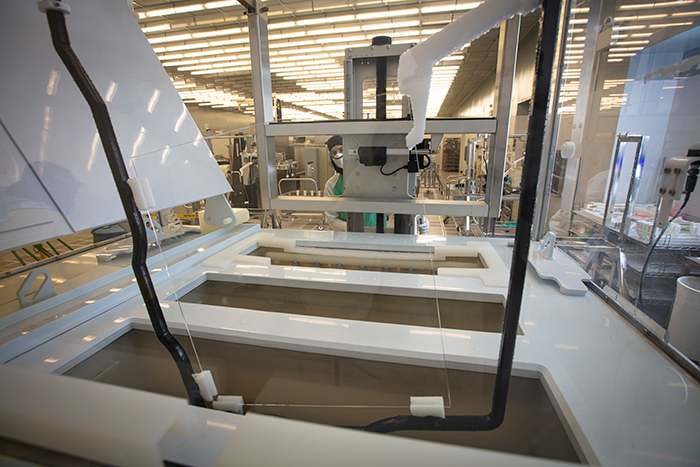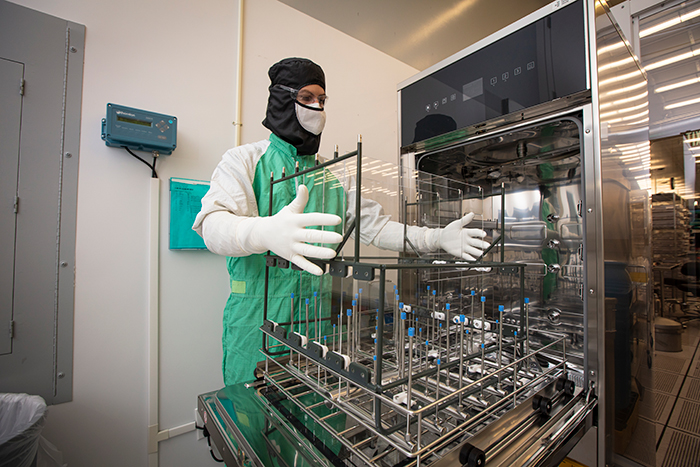Optics Meet the Demands of
Increased Laser Energy
March 29, 2023
Part 5 of “The Age of Ignition,” a NIF & Photon Science News Special Report describing the elements of Lawrence Livermore National Laboratory’s fusion breakthrough at the National Ignition Facility
If Lawrence Livermore National Laboratory (LLNL)’s National Ignition Facility (NIF) were a race car, it would run at the redline most of the time.

“NIF is the only laser system that intentionally operates above the laser damage growth threshold,” said Tayyab Suratwala, Optics and Materials Science & Technology program director. “We operate the laser at a power and energy level for which we can repair the optics at an acceptable rate.”
Pushing that envelope was an important enabler allowing LLNL to achieve ignition on Dec. 5, 2022. Since NIF became operational in 2009, the LLNL optics team has persisted in hardening the optics to withstand ever-increasing laser energy, as NIF routinely exceeded its design specification of 1.8 megajoules, and the debris that results from every experiment.
“Working in optics on NIF is like peeling an onion that is always growing,” said Suratwala. “Each time we overcome a challenge, we turn up the laser energy and create new challenges.”
The latest solution to the challenge of higher laser energy—a record 2.05 megajoules delivered in the ignition shot—is the fused silica debris shield or FSDS.
 The new FSDS optic, shown here being processed through the Advanced Mitigation Process to improve its laser damage resistance, was a critical factor in LLNL’s ability to deliver more than two megajoules of laser energy in ignition experiments. Photos by Jason Laurea
The new FSDS optic, shown here being processed through the Advanced Mitigation Process to improve its laser damage resistance, was a critical factor in LLNL’s ability to deliver more than two megajoules of laser energy in ignition experiments. Photos by Jason Laurea A Shield for the Shield
About five years ago, LLNL solved one intractable problem when researchers discovered that the disposable debris shield (DDS), which protects more valuable optics in the final optics assembly from debris, was itself a source of debris. After considering several possible solutions, including changing the DDS material, the scientists landed on adding the FSDS to the final optics assembly.
The FSDS became a shield for another shield—in this case for the grating debris shield (GDS), which is so valuable it is repeatedly repaired to extend its life as much as possible. With the optics recycling loop strategy, debris-induced laser-damaged GDS's and the wedged focus lens optics are removed, repaired, and returned to NIF at a pace of about 40 optics a week.

“The FSDS reduced the number of damage sites on the GDS by 98 percent,” said staff scientist Chris Miller. “Our installed optics are lasting three times longer. And it allows us to use a thorough recycle process.”
Before, the team only repaired GDS damage sites that were 50 microns or larger. With less damage overall, they can repair sites as small as 10 microns.
“With our optics lasting longer, we are better able to operate the laser at higher energy levels,” said Optics Damage S&T Group Leader Wren Carr.
A Complex Implementation
Adding the first major optic to NIF was no simple task. Ramping up production of the FSDS brought together many specialties including optical scientists, engineers, programmers, and procurement. The team tackled challenges like developing image analysis software to evaluate damage on the new optic and increasing throughput in the Optical Processing Facility (OPF).
“Thanks to the booming semiconductor industry, there is more demand for fused silica,” said materials scientist Lana Wong. As the component engineer for the DDS and FSDS, she led the effort to identify and qualify multiple fused silica vendors to ensure an adequate supply chain.
The FSDS was initially installed on 48 beamlines in 2021 and on 80 more a year later. Before that transition, the OPF processed four optics a week.
“We tripled production, adding another eight FSDS optics per week to our regular workload,” said process engineer Diana VanBlarcom. “It meant reworking recipes for cleaning and coating, reengineering equipment to hold multiple FSDS optics instead of one, and updating control systems, to name a few (upgrades).”
 Alex Maroudas removes a clean fused silica debris shield from the optics washer in the Optics Processing Facility.
Alex Maroudas removes a clean fused silica debris shield from the optics washer in the Optics Processing Facility. Installing the FSDS into NIF affected every area of operation. It required reprogramming NIF’s control system, the complex software that orchestrates some 66,000 control elements; designing and executing an efficient install and deinstall process; and developing processes for in-situ monitoring and removal criteria.
The FSDS went into a slot that had previously housed a metal shutter. Before each shot, this tray was moved out of the laser path.
“It was a huge change, telling the laser to shoot through an area that previously it was told never to shoot through,” said Nathan Ruiz, FSDS system manager. “Every technician working on NIF is now well-versed in the FSDS.”
“We are seeing these solutions pay off in a big way.”
—Tayyab Suratwala
The operation brought together all the facility teams: Facility and Infrastructure Systems (FinS), Laser-Alignment System Engineering (LASE), Laser Science and Systems Engineering (LSSE), the Optics Assembly Building (OAB), Optics & Materials Science & Technology (OMST), NIF&PS Control Systems (NCS), Radiation Operations, Shot Operations, and Total Online Procurement Systems (TOPS).
“On NIF, there is no margin for error. There were multiple layers of checks and balances,” Ruiz said. “And we did it right every time.”
The FSDS Implementation Team was recognized for their effort with a Department of Energy Secretary’s Honor Achievement Award for the successful implementation and production operation of FSDS optics.
Optics Improvements Continue
The FSDS built on earlier advances like the Advanced Mitigation Process (AMP), a chemical-etching method that removes damage precursors. AMP was first deployed in 2014 and revamped in 2017. Also in 2017, the optics team began using an anti-reflective coating on the GDS to prevent it from reflecting excess light back to other optics.
“From investigating a problem to deploying a solution on the NIF optics, it’s about a five- or six-year process,” said Suratwala. “We are seeing these solutions pay off in a big way.”
Another problem under investigation is the pedestal beams, the 32 beams along the bottom of NIF’s Target Chamber.
“The optics in those lower beamlines experience more debris damage, which we can attribute to some degree to gravity,” said Carr. “As the debris trickles down to the pedestal beams, it slips into small openings and finds its way through cracks and gaps.”
The FSDS won’t be installed in the pedestal beams until the NIF operations teams can significantly bring down the damage rate. They are working on mechanical debris shielding, which has been partially deployed on the 32 lower beamlines.
Carr is confident that the team will continue to make progress with the mechanical debris shielding and against other challenges, such as how to make coatings stick better to the GDS and why debris damage is also higher on the upper 32 beams of NIF.
“Our job is never done, but that’s what makes it exciting,” he said.
Next Up: “Computing Codes, Simulations Helped Make Ignition Possible”
More Information:
“The Age of Ignition: A NIF & Photon Science News Special Report”
“Five Lab Teams Recognized with Secretary’s Honor Achievement Awards,” LLNL News Release, February 8, 2023
“High-Laser-Energy Shot Puts NIF Back on Track Toward Ignition,” NIF & Photon Science News, November 7, 2022
“Robust New Debris Shields Will Boost NIF’s Shot Rate,” NIF & Photon Science News, July 8, 2021
“Next-Generation NIF Optics Boost Energy and Limit Damage,” NIF & Photon Science News, April, 2017
—Patricia Koning
Follow us on Twitter: @lasers_llnl



